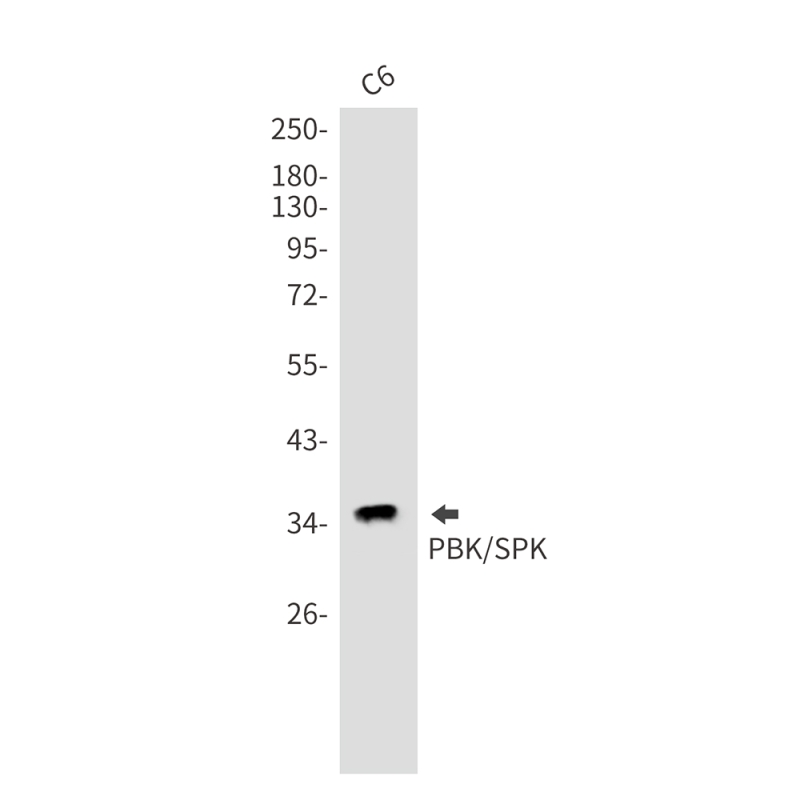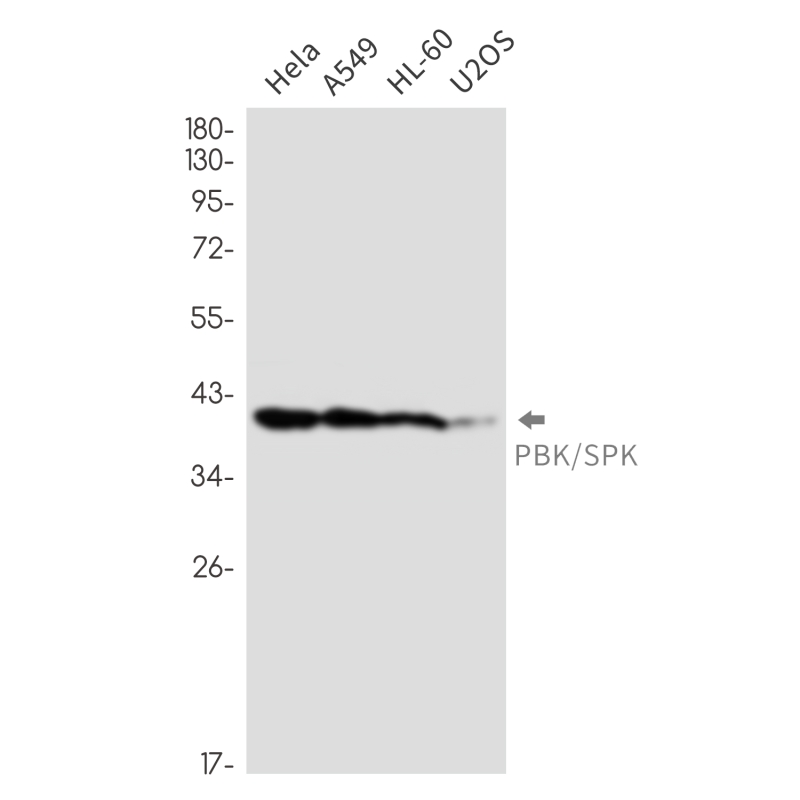


| WB | 1/500-1/1000 | Human,Mouse,Rat |
| IF | 1/20 | Human,Mouse,Rat |
| IHC | 1/50-1/100 | Human,Mouse,Rat |
| ICC | 技术咨询 | Human,Mouse,Rat |
| FCM | 咨询技术 | Human,Mouse,Rat |
| Elisa | 咨询技术 | Human,Mouse,Rat |
| Aliases | PBK; TOPK; Lymphokine-activated killer T-cell-originated protein kinase; Cancer/testis antigen 84; CT84; MAPKK-like protein kinase; Nori-3; PDZ-binding kinase; Spermatogenesis-related protein kinase; SPK; T-LAK cell-originated protein kinas |
| Entrez GeneID | 55872 |
| WB Predicted band size | Calculated MW: 36 kDa; Observed MW: 40 kDa |
| Host/Isotype | Rabbit IgG |
| Antibody Type | Primary antibody |
| Storage | Store at 4°C short term. Aliquot and store at -20°C long term. Avoid freeze/thaw cycles. |
| Species Reactivity | Human,Rat |
| Immunogen | Recombinant protein of human PBK/SPK |
| Formulation | Purified antibody in TBS with 0.05% sodium azide,0.05%BSA and 50% glycerol. |
+ +
以下是关于PBK抗体的3篇示例参考文献(注:以下文献为示例性概括,可能并非真实存在):
---
1. **文献名称**:*PBK/TOPK is a novel prognostic marker in glioblastoma and its antibody-based detection correlates with tumor proliferation*
**作者**:Abe Y, et al.
**摘要**:该研究通过免疫组化分析发现PBK在胶质母细胞瘤(GBM)中显著过表达,与患者生存期缩短相关。作者开发了一种高特异性PBK抗体,证实其与Ki-67表达呈正相关,提示PBK可能作为GBM的预后标志物及治疗靶点。
2. **文献名称**:*Development of a monoclonal antibody against PBK/TOPK for colorectal cancer diagnosis and therapeutic evaluation*
**作者**:Zhu F, et al.
**摘要**:研究团队制备了一种新型抗PBK单克隆抗体,验证其在结直肠癌组织中的特异性识别能力。通过Western blot和免疫荧光证实PBK在转移性肿瘤中高表达,且与患者化疗耐药性显著相关,为临床诊断提供了工具。
3. **文献名称**:*Targeting PBK/TOPK signaling axis suppresses breast cancer metastasis via antibody-mediated inhibition*
**作者**:Kim JH, et al.
**摘要**:该研究利用PBK抗体探究其在HER2阳性乳腺癌中的作用,发现PBK通过调控EMT通路促进转移。动物模型中,抗体阻断PBK显著抑制肿瘤生长,提示其作为靶向治疗的潜力。
---
如需实际文献,建议通过PubMed或Google Scholar检索关键词“PBK antibody”、“TOPK cancer”等获取最新研究。
PBK (PDZ-binding kinase), also known as T-LAK cell-originated protein kinase (TOPK), is a serine/threonine kinase belonging to the mitogen-activated protein kinase kinase (MAPKK) family. It plays critical roles in cell cycle regulation, DNA damage response, and mitotic progression, particularly during cytokinesis. PBK contains a kinase domain at its N-terminus and a PDZ-binding motif at the C-terminus, enabling interactions with scaffolding proteins. Its expression is tightly regulated, peaking during the G2/M phase, but is often dysregulated in cancers.
PBK antibodies are essential tools for studying the protein's expression, localization, and function in both physiological and pathological contexts. These antibodies are widely used in techniques like Western blotting, immunohistochemistry (IHC), immunofluorescence (IF), and flow cytometry to detect PBK in cell lines, tissues, or clinical samples. Researchers frequently employ PBK antibodies to investigate its overexpression in cancers, including breast, colorectal, and glioblastoma, where it correlates with tumor aggressiveness and poor prognosis. Specific antibodies targeting phosphorylated PBK (e.g., at Thr9 or Thr13) help assess its activation status, providing insights into kinase-dependent signaling pathways. Validation of antibody specificity through knockout controls or siRNA knockdown is critical due to potential cross-reactivity with structurally similar kinases. Commercial PBK antibodies are available from multiple vendors, with variations in host species, clonality, and conjugation formats to suit diverse experimental needs.
×